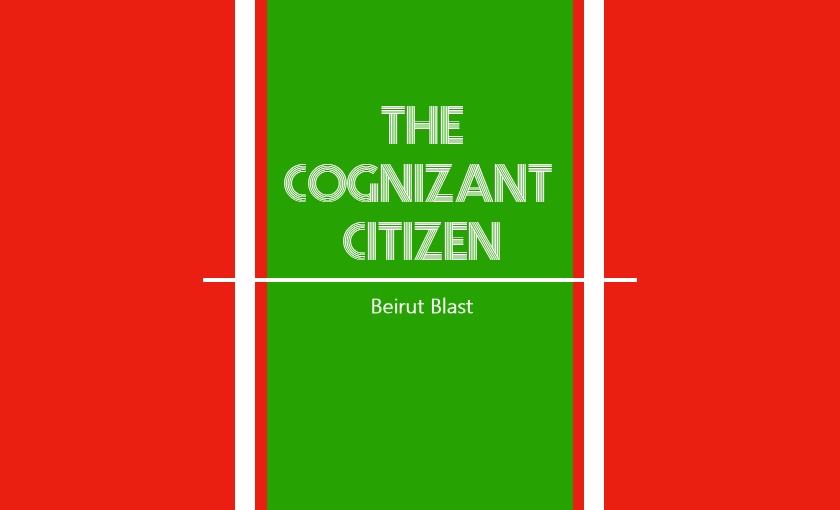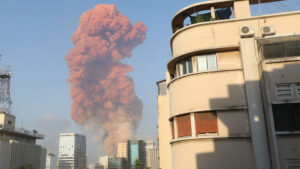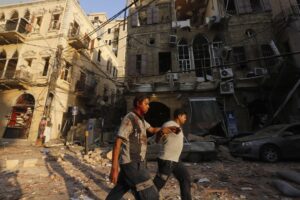
A powerful blast in port warehouses near central Beirut storing highly explosive material killed 78 people and injured nearly 4,000 on August 4th. Almost a hundred people have been reported missing, including 10 firefighters. The blast struck with the force of a 3.5 magnitude earthquake and was heard up to 200 kilometres away in the island of Cyprus, with damage being reported across the radius of the city and up to the outskirts. In initial photographs, the buildings in the immediate proximity of the blast have been flattened and badly damaged.
In an official statement, the cause of the explosion was confirmed to be ammonium nitrate, a chemical mainly used in agriculture and explosives. The chemical had been stored in a warehouse since 2013 when it was seized by the government. Because of its highly reactive nature, several regulations exist for its storage and usage, especially that it must be kept away from fuels and heat. In Europe, it must be mixed with calcium carbonate to reduce the risk of explosion. In the USA, following a two-tonne explosion in 1995 that killed 169, stringent regulations were put in place for its use. If safely stored, the chemical is unlikely to trigger itself in the absence of contaminants. In Beirut’s case, a smaller explosion caused a further reaction leading to a disaster.
Health Facility Crisis
The blast comes at a difficult time for Lebanon, which had just completed a 5-day lockdown in the worsening COVID-19 situation. Citizens had been flouting safety norms by attending and hosting large gatherings. The country has 5062 cases and 63 deaths to date, and the number is growing steadily at 100 cases per day. As a consequence of the explosion, six medical staff members were killed and a hospital was severely damaged. Many patients, including cancer survivors, faced injuries. In the aftermath of the situation, citizens reported a shortage of hospital beds and medical attention amidst the coronavirus pandemic and a crippling economic crisis.
Political & Regional Conflict:
As a country, Lebanon is, unfortunately, no stranger to tragedies causing loss of life.
A civil war fought along political and sectarian lines raged between 1975 and 1990, killing 120,000 and exiling one million, before parts of Lebanon were occupied by both Syria and Israel for close to two decades. The war split the nation between the country’s warring ethnic groups, as a consequence of which the main political offices – president, speaker of parliament, and prime minister – were divided among the three biggest ethnic communities (Maronite Christian, Shia Muslim, and Sunni Muslim, respectively).
Since the end of the civil war, political leaders from each sect have maintained their power and influence through a system of patronage networks, protecting the interests of the religious communities they represent, and offering – both legal and illegal – financial incentives.
The Iran-backed Shia movement Hezbollah, which fought a month-long war against Israel in 2006, emerged as a resistance movement against the Israeli occupation of Lebanon. It is widely seen as the most powerful military and political group in Lebanon.
In 2013 Hezbollah announced it was fighting alongside the regime of President Bashar al-Assad of Syria, further dividing the Lebanese political scene and leading to sanctions that reduced the amount of Gulf money, in the form of tourism and remittances, flowing into the country. The Syrian conflict has sporadically spilt over into Lebanon, with several attacks rocking Beirut and the regions. However, the most visible impact of the Syrian war in Lebanon, a country of around 4.5 million people, has been the influx of an estimated 1.5 million refugees. This influx has posed an economic and social burden onto a state ill-equipped to assist refugees.
Economic Crisis
Beirut port, which was the epicentre of the explosion, is the country’s main logistics hub and its deepest seaport. It provided around 80 percent of imported goods, which kept the economy moving. Economic damage from the blast is being estimated in the billions of dollars. The disaster is projected to have a drastic impact on food security.
The citizens of the country are caught between poor governance and rampant corruption. Unemployment stands at 35% and nearly half of the country’s population lives below the poverty line. The lira (Lebanese pound) has lost 80% of its value in the last 10 months, pushing up the price of imported goods by up to five times. Lebanon is in more than $90 billion in debt; nearly 170% of its GDP—one of the highest debt ratios in the world.
The economic crisis is a result of a state-sponsored pyramid scheme, run by the Central Bank, which was borrowed from commercial banks at above-market interest rates to pay back its debts and maintain the Lebanese pound’s fixed exchange rate with the US dollar. Earlier in March, Lebanon announced it was defaulting on its debts.
With Lebanon heavily reliant on imports, the issues regarding currency are having a crippling effect on purchasing power. Prices rose more than 56% in May compared to a year ago, with food costs going up nearly 190%, according to official statistics.
On April 30th, the country sought $10 billion from The International Monetary Fund aimed at securing vital aid, under a plan to stabilize the economy adopted by the government. However, talks have since stalled. Many Lebanese citizens who rely on hard currency savings have fallen into poverty due to capital controls, as banks restrict dollar withdrawals. Those who can are stockpiling canned food, cooking gas and other essentials in anticipation of shortages. Other desperate families are turning to Facebook pages for bartering personal belongings like clothes and furniture in exchange for cooking oil, baby formula and other basic necessities.
Protests
In October 2019, the government proposed new taxes on tobacco, petrol and voice call via messaging services such as WhatsApp to drum up more revenue. The backlash forced the government to cancel the proposed tax within hours, but it appeared to unleash a surge of discontent that had been simmering in Lebanon for years.
Tens of thousands of protestors assembled in at least 70 cities across the country accusing the political leadership of corruption and calling for social and economic reforms. Public anger escalated over electricity and water shortages, as well as the government’s failure to manage the country’s waste and economic crises. The protests, which were fiercely non-sectarian, paralysed the country and led to the resignation of Saad Hariri as prime minister. Not much has changed under Lebanon’s current government, led by Prime Minister Hassan Diab, as blackouts and the economic crisis worsen.
Petitions and Donations
The tragedy has garnered worldwide attention and sympathy. To support the people of Lebanon, visit the following petition links:
https://www.change.org/p/united-nations-support-people-in-lebanon-after-unexpected-explosion
https://www.nationalsalvationcharter.org/
Donate here:
Disaster relief crowdfunding
https://www.justgiving.com/crowdfunding/lebanon-relief?utm_term=PYp7gXzyD
Donate to the Lebanese Red Cross
https://www.supportlrc.app/donate/
Written by Abha Deo and Pahal Duggal for MTTN
Edited by Kalyani Nandagopal for MTTN
Featured image by Rovin Negi for MTTN
Image Credits (in order): Wall Street Journal, The New York Times


Leave a Reply
You must be logged in to post a comment.